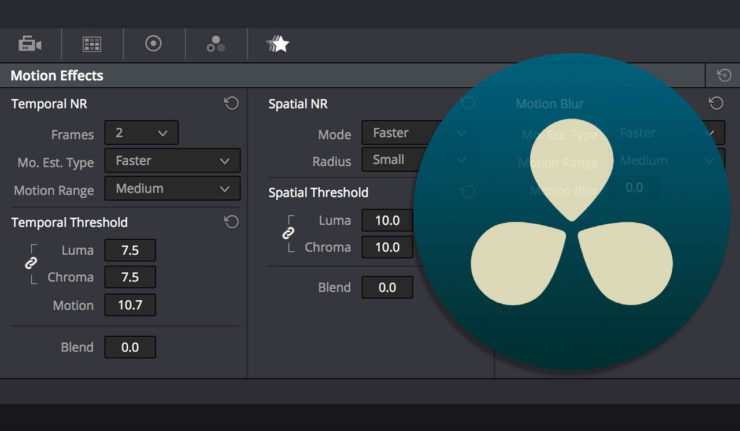The Motion Effects Palette enables you to apply Spatial or Temporal noise reduction and artificial motion blur. Noise reduction requires quite a bit of GPU processing power to subdue noise.
Spacial NR
Controls smooth out regions of high frequency, preserving detail without having to soften. A smaller radius will have faster performance, and a large radius will result in higher quality for areas that have strong visual detail at high Luma and Chroma values. The Luma Threshold limits or adds to the noise reduction applied to the Luma channel. Whereas the Chroma Threshold limits or adds to the noise reduction applied to the Chroma by smoothing out regions of high-frequency noise. Having the Luma and Chroma settings linked will make adjustments to both, if you unlink these you can lower the Luma Threshold to preserve detail, while raising the Choma Threshold to eliminate colour noise. You can limit the effect of the noise reduction with the NR Blend, 0 is invisible, 100 is fully visible.
Temporal NR
analyzes multiple frames of an image to isolate noise from detail. Number of Frames sets the amount of frames you want Resolve to average in order to isolate detail from noise. 2 frames gives you the best analysis, but can create weird artificating. 1 will give you better results for fast-moving images. Motion Est. Type, Motion Range, and Motion threshold all control how resolve interprets the image. These can be set for optimized performance, or for enhanced computation to make sure the best detailed results will be exported. My suggestion is trying Temporal NR first, as its analyzes multiple frames and can yield a better result. The node placement for noise can determine a better result, or worse depending on the source material, and how far you push the information.
Motion Blur
Uses motion estimation to add artificial motion blur to clips. The Motion Est. Type can be Faster to optimize performance and not be as precise of a blur, or Better will require more processing but create a better result. Motion Range determines the speed of motion to consider when trying to define the areas being blurred. With Motion Blur, you can increase or decrease the intensity of the blur.


